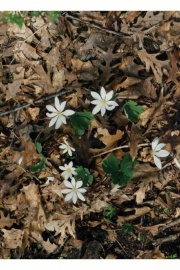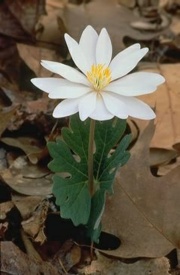Difference between revisions of "Bloodroot"
(username removed) |
|||
| (One intermediate revision by one other user not shown) | |||
| Line 1: | Line 1: | ||
| − | [[File:bloodrootPD1.jpg|thumb|Bloodroot | + | [[File:bloodrootPD1.jpg|thumb|Bloodroot ''Sanguinaria canadensis'']] |
| − | |||
| − | ''Sanguinaria canadensis'']] | ||
== Description == | == Description == | ||
A perennial wildflower (''Sanguinaria canadensis'') of the poppy family indigenous to shady woodlands in eastern and central North America. Each bloodroot stem produces a single white flower in early spring. The plants have a deep red color root that was an important orange dye for native Americans. It was used for dyeing cloths, as a war paint, and as a colorant for porcupine quills, tomahawks, rattles, and baskets. Unmordanted dyes give an orange color while aluminum and tin mordants produce a tan and chrome mordants give an dark orange-brown color. The primary colorants are alkaloids like isoquinoline protopine. Powdered bloodroot should be obtained from supply stores since gathering the plant is restricted in many areas because of its scarcity. | A perennial wildflower (''Sanguinaria canadensis'') of the poppy family indigenous to shady woodlands in eastern and central North America. Each bloodroot stem produces a single white flower in early spring. The plants have a deep red color root that was an important orange dye for native Americans. It was used for dyeing cloths, as a war paint, and as a colorant for porcupine quills, tomahawks, rattles, and baskets. Unmordanted dyes give an orange color while aluminum and tin mordants produce a tan and chrome mordants give an dark orange-brown color. The primary colorants are alkaloids like isoquinoline protopine. Powdered bloodroot should be obtained from supply stores since gathering the plant is restricted in many areas because of its scarcity. | ||
| − | [[File:image9_bloodroot.jpg|thumb|Bloodroot | + | [[File:image9_bloodroot.jpg|thumb|Bloodroot ''Sanguinaria canadensis'']] |
| − | |||
| − | ''Sanguinaria canadensis'']] | ||
== Synonyms and Related Terms == | == Synonyms and Related Terms == | ||
''Sanguinaria canadensis''; sanguinaria del Canadà (It.); red puccoon | ''Sanguinaria canadensis''; sanguinaria del Canadà (It.); red puccoon | ||
| − | == | + | ==Resources and Citations== |
* Random House, ''Webster's Encyclopedic Unabridged Dictionary of the English Language'', Grammercy Book, New York, 1997 | * Random House, ''Webster's Encyclopedic Unabridged Dictionary of the English Language'', Grammercy Book, New York, 1997 | ||
| Line 27: | Line 23: | ||
* John and Margaret Cannon, ''Dye Plants and Dyeing'', Herbert Press, London, 1994 | * John and Margaret Cannon, ''Dye Plants and Dyeing'', Herbert Press, London, 1994 | ||
| − | * Website | + | * Website: http://www1.umn.edu/ships/scimath/dyes2.htm#History |
[[Category:Materials database]] | [[Category:Materials database]] | ||
Latest revision as of 15:18, 8 May 2022
Description
A perennial wildflower (Sanguinaria canadensis) of the poppy family indigenous to shady woodlands in eastern and central North America. Each bloodroot stem produces a single white flower in early spring. The plants have a deep red color root that was an important orange dye for native Americans. It was used for dyeing cloths, as a war paint, and as a colorant for porcupine quills, tomahawks, rattles, and baskets. Unmordanted dyes give an orange color while aluminum and tin mordants produce a tan and chrome mordants give an dark orange-brown color. The primary colorants are alkaloids like isoquinoline protopine. Powdered bloodroot should be obtained from supply stores since gathering the plant is restricted in many areas because of its scarcity.
Synonyms and Related Terms
Sanguinaria canadensis; sanguinaria del Canadà (It.); red puccoon
Resources and Citations
- Random House, Webster's Encyclopedic Unabridged Dictionary of the English Language, Grammercy Book, New York, 1997
- The American Heritage Dictionary or Encarta, via Microsoft Bookshelf 98, Microsoft Corp., 1998
- Encyclopedia Britannica, http://www.britannica.com Comment: "puccoon" [Accessed March 5, 2002]. "bloodroot" [Accessed March 5, 2002
- G.S.Brady, Materials Handbook, McGraw-Hill Book Co., New York, 1971 Comment: p. 283
- Palmy Weigle, Ancient Dyes for Modern Weavers, Watson-Guptill Publications, New York, 1974
- John and Margaret Cannon, Dye Plants and Dyeing, Herbert Press, London, 1994

